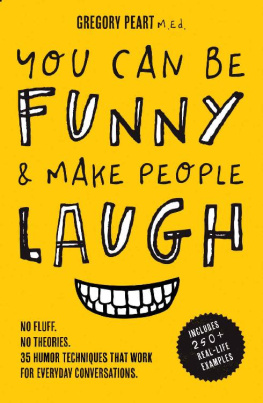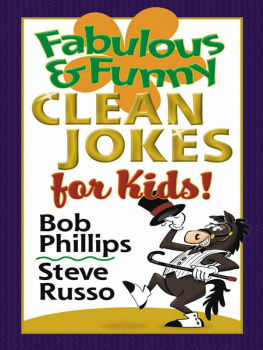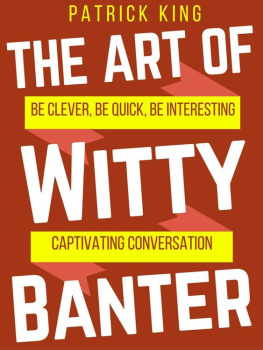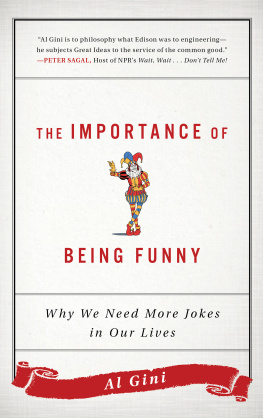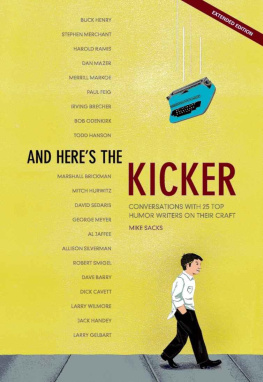You Can Be Funny and
Make People Laugh
Also available
The Small Talk Code: The Secrets of Highly Successful Conversationalists
How to Talk Business Like a Boss: 53 Proven Techniques for Conquering Any Work Situation
My old sketchbook from 3rd grade art class. Just kidding, I have no idea where I put that thing.
You Can Be Funny and
Make People Laugh
No Theories. No Fluff. 35 Humor Techniques that Work for Everyday Conversations.
Geoffrey Gregory Peart, M.Ed.
Aurelius Books

Copyright 2019 by Geoffrey Peart
All rights reserved. No part of this publication may be reproduced, distributed or transmitted in any form or by any means, including photocopying, recording, or other electronic or mechanical methods, without the prior written permission of the publisher, except in the case of brief quotations embodied in critical reviews and certain other noncommercial uses permitted by copyright law. Any questions or comments should be directed to the contact information below:
Aurelius Books
Brighton, MI 48116
This publication is designed to provide accurate and authoritative information in regard to the subject matter covered. It is sold with the understanding that the author is not a licensed therapist, and all advice is based on his own experiences. If you need professional help, please seek out resources in your area.
The names in my examples have been changed for privacy reasons.
Book Cover Design 2019 Geoffrey Peart
How to be funny and make people laugh: No theories. No fluff. 35 humor techniques that work for everyday conversations/ Geoffrey Gregory Peart 1st ed.
ISBN-13: 978-1-7321791-6-5
To all the friends and family who made me laugh when times were tough. And to all the friends and family who made me laugh when times were easy. You all taught me how to appreciate the joy in the world. For that, I am eternally grateful.
To Mr. Elmleaf, my 7th grade math teacher: You tried so hard to get this overly serious guy to laugh, but I never cracked a smile. One time, you pulled me to the side after class and gave me a special homework assignment: Go home, find something you think is funny, and come back and tell me what it is. I was too shy and serious to listen to your advice at that time, but Ive always remembered what you told me, Mr. Elmleaf. I may be a little late completing my homework, but I hope this book counts.
The Contents
Hey, Want to Hear a Joke?
Americans type the keywords knock knock jokes into Google searches more than 368,000 times a month. In case you were wondering, I checked out how often Americans type killer knock knock jokes, and its 590 times a month (as of May 2019). If I wanted to kill my conversations, killer knock-knock jokes would certainly be my verbal weapon of choice.
The unfortunate (and unfunny) reality is that reciting jokes from joke books wont make you funny. Every time my father-in-law starts a conversation with, Hey, did you hear the joke about part of me dies inside. I know the joke hes about to tell wont be funny because contrived jokes rarely ever are. However, because hes my father-in-law and because Im a polite, well-mannered person, I force a smile and a pity laugh so he can save face and we can continue arguing about politics.
This book is about conversational humor, or how to add a little appropriate fun and playfulness into a conversation so that the people involved end up relating to each other better and feeling better connected. Conversational humor is more than just setups and punchlinesits complicated. Save the scripted jokes for comedians. Instead, focus your mental energy on practicing and remembering techniques that can be naturally applied to everyday social situations. I just might know 35 of those kinds of techniques perfectly suited for conversations.
Ill be honest: you wont like all the techniques in this book. In fact, youll probably think some of the examples are silly, strange, or downright stupid. But the good news is youll also love some of them and think some of the examples are hilarious. And thats the thing about humor; its not a one-size-fits-all type of deal.
I find the subtle glances that the characters exchange on the popular show, The Office, hilariousbut my wife looks at me like Im crazy when I laugh at them. Theres a reason no one in history has nailed down a universally-accepted definition of humor; its a futile exercise because what people find funny differs from person to person and from situation to situation. Youd have better luck trying to herd a clowder of cats (Did you know that a group of cats is called a clowder? Seriously. I didnt believe it either.)
Unfortunately, some humor will naturally get lost in translation and in print form, and thats a risk Im taking with this book. The delivery of the line, the energy, the mood, the inflections, and the personalities of the other people listening (and how many Gin and Tonics they drank that night) all factor into whether the comment is funny or dog-doo.
Youll just have to take my word that every example included in this book had the effect of making someone laugh at some point. If or when you come across an example that you dont find particularly funny, try to revise or restate it in a way that is funny to you. It will help you develop your own humorous style or voice.
Full disclosure: Unless you count that one time my little brother paid me a quarter to hear a joke, Im not a professional comedian. Im just someone who really wanted to learn how to be funny, and I became fascinated (my wife would say completely obsessed) with studying funny people. After spending fifteen years writing down and analyzing more than 17,000 conversations, a number of techniques emerged from the small talk rubble that I found useful, and I think you will, too.
I didnt personally create the techniques. Its more like I discovered them; I was just fortunate enough to be exposed to a lot of funny people over the years. After years of note-taking, studying, and analyzing, I was able to identify certain common characteristics that seemed to get a smile or a laugh. As a result of practicing the techniques in my own conversations, my ability to make people laugh increased until it eventually became second nature. But it wasnt always easy.
Travel back in time with me for a minute. When I was sixteen, a girl sitting at my table in art class turned toward me and remarked ever so politely, You should try to find a personality. She was trying to offer advice, but her words hit me like a ton of bricks. I knew I was shy, but I didnt think my shyness was to the point that random people felt pity for me, like I was some down-and-out stray dog needing a hug and some leftover chicken wings. Where does one find a personality anyway? Last I checked, Amazon wasnt selling those yet. Her insensitive adolescent comment jumpstarted my journey into the self-improvement world.
Fast-forward to age thirty-one, and Im in a meeting with a colleague. She remarks, You know what I like about you? I appreciate that you can be really funny without being negative toward other people. That kind of humor is really rare. That was the greatest compliment I had received in years. I thought to myself, Mission accomplished! Not only was I rapidly ascending in my career and socially confident, but it was official: I was officially deemed funny.
Ive written other social skills books, but I consider humor to be the most advanced and most life-changing topic. Theres a reason its so highly coveted: humor is power. Humor helps build connections and relationships in ways that few other social interactions can. It makes all participants feel good (laughing naturally releases dopamine). It brings people together in shared positive experiences that are memorable and lasting. You may be one of the millions of people who have

